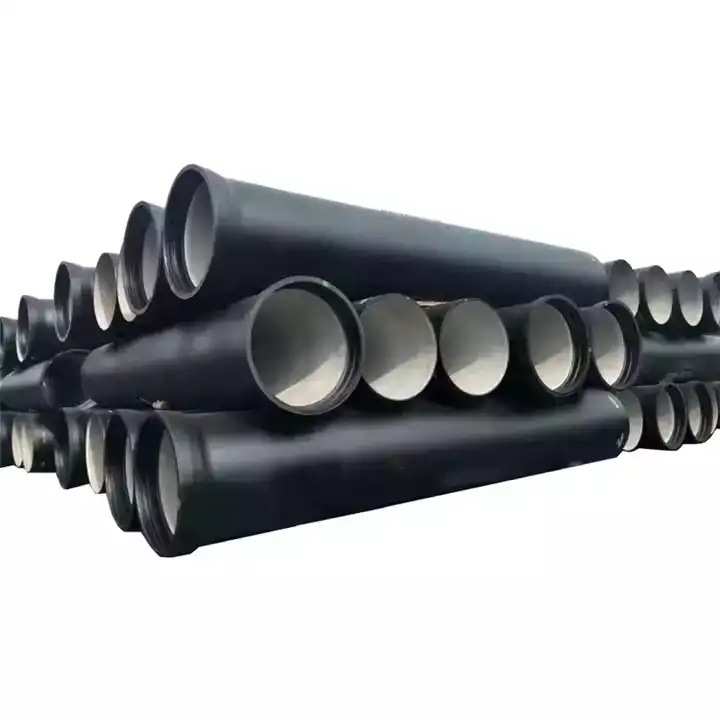A ductile iron pipe’s “K” designation refers to a thickness class coefficient defined by international standards (ISO 2531/EN 545 and IS 8329), used to calculate the wall thickness needed for given diameters and service conditions. Among the series, K9 is the most common “national standard” class balancing strength and economy. Compared with C‑series pipes—which are classified by allowable working pressure—K‑series pipes are classified strictly by wall‑thickness requirements, offering superior resistance to both internal pressure and external loads. Properly designed and installed, a ductile iron Class K pipeline can serve 100+ years with minimal maintenance. For plumbing applications, Type K and L copper pipes follow a similar principle—wall thickness designations for differing service uses.

What Does “K” Mean in Ductile Iron Pipe?
The prefix “K” stands for a thickness‐class coefficient used in the formula:
e=K×(0.5+0.001×DN)
where e is the nominal wall thickness in millimeters and DN is the pipe’s nominal diameter in millimeters. This method reflects both internal pressures and external loading (earth, traffic, etc.) in the wall‐thickness design, unlike other materials that consider only fluid pressure.
What Is “K” in K9?
-
K9 indicates a thickness class of 9, yielding a wall thickness computed via the above equation.
-
For example, at DN 200 mm:
e=9×(0.5+0.001×200)=9×0.7=6.3 mm
-
K9 is widely adopted as the “national standard” for potable water mains, balancing adequate thickness (and thus strength) with economy.
Class K Series: Introduction & Comparison
| Class (K) | Formula | e@DN 200 mm (mm) | e@DN 300 mm (mm) | Notes |
|---|---|---|---|---|
| K7 | 7 × (0.5 + 0.001 DN) | 7 × 0.7 = 4.9 | 7 × 0.8 = 5.6 | Minimum e = 5 mm for K7 |
| K8 | 8 × (0.5 + 0.001 DN) | 8 × 0.7 = 5.6 | 8 × 0.8 = 6.4 | Minimum e = 6 mm for K8 |
| K9 | 9 × (0.5 + 0.001 DN) | 6.3 | 7.2 | Most popular “national” standard |
| K10 | 10 × (0.5 + 0.001 DN) | 7.0 | 8.0 | Custom for very high pressures |
| K11 | 11 × (0.5 + 0.001 DN) | 7.7 | 8.8 | |
| K12 | 12 × (0.5 + 0.001 DN) | 8.4 | 9.6 | Minimum e = 7 mm for K12 |
Data derived from ISO 2531/EN 545 dimensions (e.g., Wikipedia table shows K9 at 6.3 mm and K10 at 7.2 mm for DN 300 mm).
Note: C‐series pipes (C25, C30, C40) are classified by working pressure, not wall thickness.
Advantages of Class K Series
-
Higher Internal Pressure Rating
-
Thicker walls allow K‑series pipes to withstand greater hydrostatic pressures than equivalent C‑series grades.
-
-
Enhanced External Load Resistance
-
Wall thickness is designed to resist trench loads, vehicle traffic, and soil movements, reducing reliance on over‐compacted backfill.
-
-
Standardized External Diameter
-
All thickness classes share the same external dimensions, ensuring seamless joint compatibility and simple replacement.
-
Lifespan of Class K Pipes
Modern ductile iron pipes, with cement‐mortar linings and zinc/epoxy coatings, plus loose polyethylene sleeving in aggressive soils, exhibit service lives exceeding 100 years. The Ductile Iron Pipe Research Association (DIPRA) reports that well‐designed and maintained systems can surpass a century of reliable service, making them both cost‐effective and sustainable over their life cycle.
Difference Between K and L Pipes (Copper)
| Attribute | Type K Copper | Type L Copper |
|---|---|---|
| Wall Thickness | Thickest; highest strength; ideal for underground | Medium; standard for interior water lines, some underground |
| Typical Marking | Green printing | Blue printing |
| Common Uses | Water mains, service lines, high‐pressure systems | Residential/commercial branch lines, fire protection |
| Cost | Highest cost | Lower than K; still moderate durability |
Type K copper has the thickest walls of the standard plumbing tubes, used for deep‐buried or high‐pressure applications; Type L is thinner, more common, and suitable for indoor and moderate outdoor uses.
FAQ
Q1: What’s the difference between Class K and Class C ductile iron pipes?
-
Class K is categorized by wall thickness (thickness classes K7–K12), while Class C is categorized by working pressure (C25–C40). Class K pipes generally offer higher pressure and external load capacity for the same diameter.
Q2: Why is K9 called the “national standard”?
-
K9 balances cost, thickness, and strength, meeting most municipal water utility requirements under ISO 2531/EN 545, making it the default class in many countries.
Q3: How do I choose between Type K and L copper tubing?
-
Use Type K for underground mains or high‐pressure installations; Type L for indoor supply lines, fire protection, or moderate pressure needs.
By structuring wall‐thickness design around the K coefficient, ductile iron pipes deliver unmatched reliability and longevity in water infrastructure, while similar principles guide copper tubing selection via Types K and L.
References:
- ISO 2531:2009 – Ductile iron pipes, fittings, accessories and their joints for water applications
- DIPRA – Designing Ductile Iron Pipe for External Loads
- Wikipedia – Ductile Iron Pipe
- EN 545:2010 – Ductile iron pipes, fittings, accessories and their joints for water pipelines
- Copper Development Association – Types of Copper Tube
